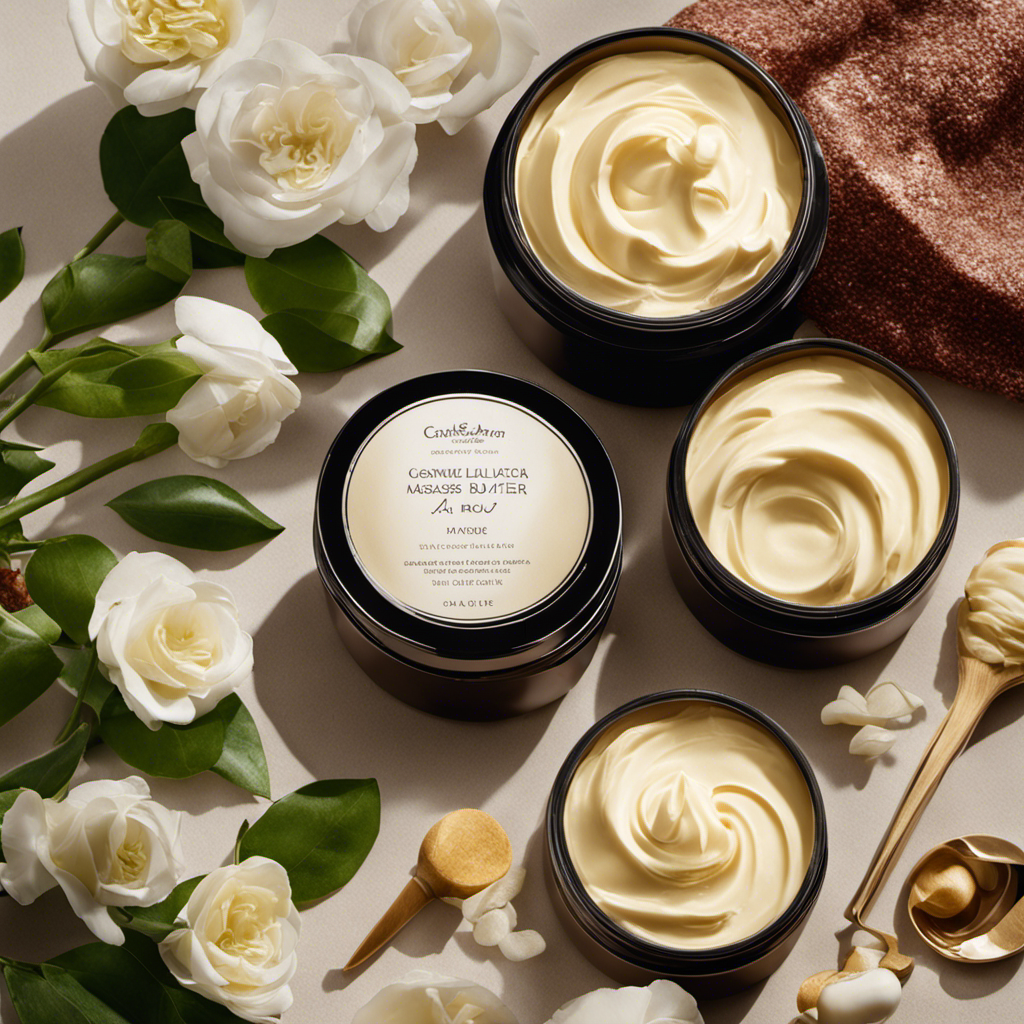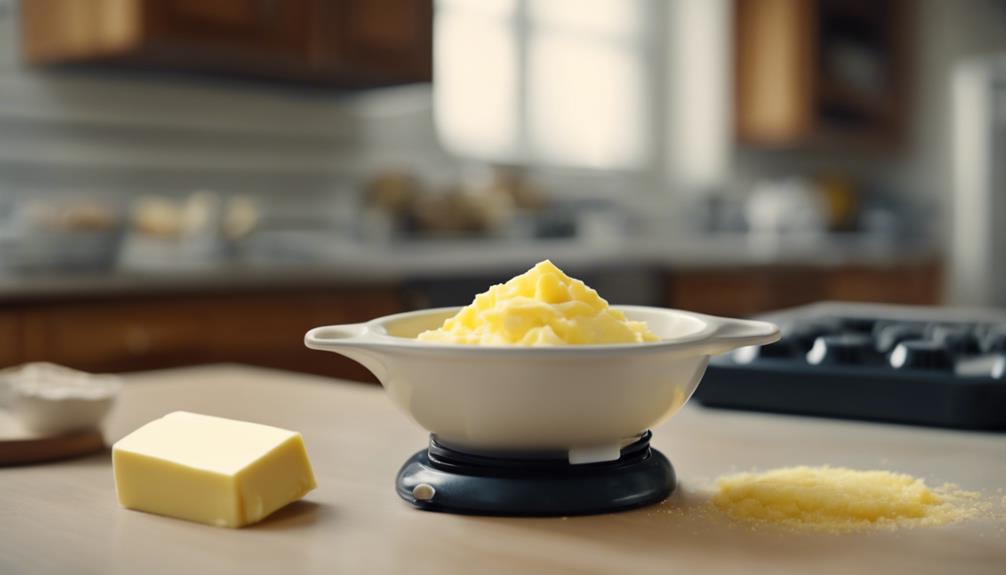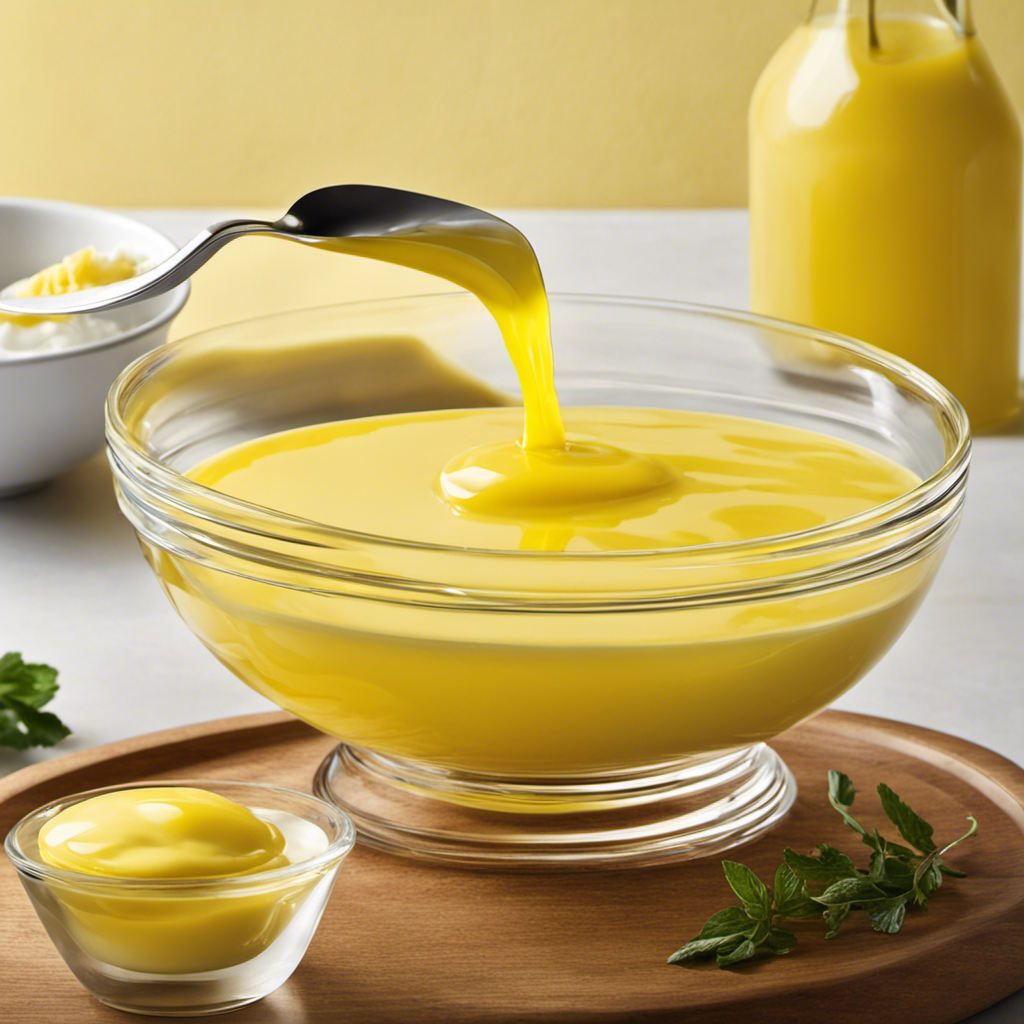Hi there!
Have you ever wondered what body butter actually does for your skin? Well, let me fill you in on all the juicy details.
Body butter is an absolute game-changer when it comes to moisturizing and nourishing your skin. It’s like a luxurious treat for your body, providing long-lasting hydration and helping to repair and protect your skin from dryness and environmental factors.
Trust me, once you start using body butter, you’ll wonder how you ever lived without it!
Key Takeaways
- Body butter provides long-lasting hydration and helps repair and protect the skin from dryness and environmental factors.
- It improves the overall health and appearance of the skin by reducing the appearance of dry patches, flakiness, and roughness.
- Body butter deeply moisturizes the skin and nourishes it with essential fatty acids, vitamins, and antioxidants.
- It also restores elasticity, promotes a smoother texture, and can be customized with different scents and textures.
Benefits of Using Body Butter
Using body butter can provide numerous benefits for your skin. Not only does it provide hydration benefits, but it also offers various skin benefits.
Body butter is a thick and creamy moisturizer that contains rich and nourishing ingredients like shea butter, cocoa butter, and essential oils. When applied to the skin, body butter forms a protective barrier that helps to lock in moisture and prevent dehydration. This intense hydration helps to improve the overall health and appearance of the skin, making it softer, smoother, and more supple.
Additionally, body butter can help to reduce the appearance of dry patches, flakiness, and roughness, leaving your skin looking and feeling healthy and rejuvenated.
How Body Butter Moisturizes the Skin
Contractions:
Body butter moisturizes the skin by deeply hydrating and nourishing it. When applying body butter, it forms a protective barrier on the skin, preventing moisture loss and locking in hydration.
Here are three key benefits of using body butter:
-
Intense Hydration: Body butter contains rich emollients like shea butter and cocoa butter, which penetrate deep into the skin’s layers, providing long-lasting moisture. This helps to alleviate dryness and roughness, leaving the skin soft and supple.
-
Nourishment: Body butter is packed with essential vitamins and fatty acids that nourish the skin, promoting its overall health and radiance. These nutrients help to repair damaged skin cells and improve elasticity.
-
Soothing and Smoothing: The thick and creamy texture of body butter allows for easy and smooth application. It also has a soothing effect on irritated or inflamed skin, providing relief and leaving the skin feeling refreshed.
Overall, body butter is an excellent addition to your skincare routine, offering deep hydration, nourishment, and a soothing experience for your skin.
Nourishing Properties of Body Butter
To nourish your skin, body butter deeply penetrates with rich emollients, essential vitamins, and fatty acids, promoting overall health and radiance. Body butter offers numerous benefits for the skin due to its unique formulation and ingredients.
It provides intense hydration, locking in moisture and preventing dryness. The emollients in body butter help to soften and smooth the skin, improving its texture and appearance. Additionally, body butter contains essential vitamins such as vitamin E, which acts as an antioxidant, protecting the skin from environmental damage. The fatty acids present in body butter are crucial for maintaining the skin’s moisture barrier, preventing water loss and retaining moisture within the skin.
There are different types of body butter available, including shea butter, cocoa butter, and mango butter, each offering their own unique benefits and properties. Shea butter is deeply moisturizing and can soothe dry, irritated skin. Cocoa butter is rich in antioxidants and can improve skin elasticity. Mango butter is lightweight and easily absorbed, making it suitable for all skin types.
Incorporating body butter into your skincare routine can help nourish and revitalize your skin, leaving it feeling soft, supple, and radiant.
Why Body Butter Is Great for Dry Skin
Dry skin can greatly benefit from the nourishing properties of body butter. When it comes to sensitive skin, body butter can be a game-changer. Here are three reasons why body butter is great for dry, sensitive skin:
-
Deep Hydration: Body butter is formulated with rich, emollient ingredients like shea butter and cocoa butter. These ingredients penetrate deep into the skin, providing intense hydration and nourishment.
-
Protection: Body butter creates a protective barrier on the skin, shielding it from environmental aggressors and preventing moisture loss. This is especially beneficial for those with eczema, as it helps soothe and calm irritated skin.
-
Long-Lasting Moisture: Unlike lotions or creams, body butter has a thicker consistency that locks in moisture for longer periods. This means your skin stays hydrated throughout the day, even in harsh weather conditions.
Skin-Repairing Abilities of Body Butter
For those with damaged skin, body butter can work wonders in repairing and rejuvenating your complexion.
Body butter is a rich, creamy moisturizer that is packed with nourishing ingredients such as shea butter, cocoa butter, and oils like jojoba or almond oil. These ingredients have skin rejuvenating benefits as they are deeply moisturizing and help to restore the skin’s natural barrier function.
Body butter also contains vitamins and antioxidants, which can help to repair damaged skin by promoting cell turnover and collagen production. The emollient properties of body butter create a protective layer on the skin, preventing further moisture loss and allowing the skin to heal.
Overall, using body butter regularly can significantly improve the appearance and texture of damaged skin.
As we delve deeper into the benefits of body butter, let’s explore how it improves skin elasticity.
How Body Butter Improves Skin Elasticity
After discussing the skin-repairing abilities of body butter, let’s delve into how it improves skin elasticity.
Body butter is packed with nourishing ingredients that benefit the skin in multiple ways. Here are some ways body butter helps improve skin elasticity and reduce wrinkles:
- Hydrates the skin: Body butter deeply moisturizes the skin, providing it with essential hydration to maintain its elasticity.
- Boosts collagen production: Body butter contains ingredients like shea butter and cocoa butter, which promote collagen synthesis in the skin, making it more firm and supple.
- Provides essential nutrients: Body butter is rich in vitamins and antioxidants that nourish the skin, helping it maintain its elasticity and reducing the appearance of wrinkles.
With its ability to improve firmness and reduce wrinkles, body butter is a fantastic addition to your skincare routine.
Now, let’s explore the soothing effects of body butter on irritated skin.
Soothing Effects of Body Butter on Irritated Skin
To calm irritated skin, apply body butter generously, allowing the nourishing ingredients to soothe and hydrate your irritated skin. Body butter is a rich and creamy moisturizer that provides soothing effects for irritated skin.
It contains ingredients like shea butter, cocoa butter, and essential oils that help reduce redness and inflammation. These ingredients have anti-inflammatory properties that calm the skin and promote healing.
Shea butter, in particular, is known for its ability to deeply moisturize and nourish the skin, helping to restore its natural barrier function. Cocoa butter, on the other hand, is rich in antioxidants that protect the skin from environmental damage.
Body Butter as a Natural Remedy for Rough Patches
When applied generously, body butter can effectively alleviate rough patches on the skin. It is a natural remedy that can be made at home using simple ingredients.
Here are some benefits of using body butter:
-
Deeply moisturizes: Natural ingredients like shea butter and coconut oil penetrate the skin, providing long-lasting hydration.
-
Nourishes the skin: Body butter is rich in essential fatty acids, vitamins, and antioxidants that nourish and protect the skin.
-
Restores elasticity: The emollient properties of body butter help improve the skin’s elasticity, reducing the appearance of rough patches and promoting a smoother texture.
To make your own body butter, you can mix ingredients like shea butter, cocoa butter, and essential oils. The homemade recipes allow you to customize the scent and texture to suit your preferences.
How Body Butter Enhances Skin Tone and Texture
When it comes to achieving smoother, even skin, body butter is a game-changer.
Not only does it provide deep hydration to the skin, but it also helps to improve skin tone and texture.
The rich and creamy texture of body butter allows it to penetrate deeply into the skin, delivering essential nutrients and moisture that can help brighten the complexion and improve skin elasticity.
Smoother, Even Skin
Using body butter regularly can help you achieve smoother, more even skin. Body butter is a thick, creamy moisturizer that deeply nourishes and hydrates the skin. It contains rich ingredients like shea butter, cocoa butter, and oils that work together to improve the texture and tone of your skin.
Here are three ways body butter can help you achieve smoother, even-toned skin:
-
Hydration: Body butter provides intense hydration, which helps to plump and smooth the skin, reducing the appearance of roughness and dryness.
-
Exfoliation: Some body butters contain gentle exfoliating agents that help to slough off dead skin cells, revealing a smoother, fresher layer of skin.
-
Nutrient-rich: The ingredients in body butter are packed with essential nutrients and antioxidants that can improve the overall health of your skin, resulting in a more even complexion.
With its ability to moisturize, exfoliate, and nourish the skin, body butter sets the stage for the next section about how it brightens the complexion.
Brightens Complexion
To achieve a brighter complexion, you’ll notice that your skin looks more radiant and glowing after consistently using body butter. Body butter is a skincare product that contains nourishing ingredients like shea butter, cocoa butter, and essential oils.
These ingredients work together to provide deep hydration to the skin and improve its overall tone. The rich texture of body butter allows it to penetrate deeply into the skin, delivering essential nutrients and antioxidants. This helps to brighten the complexion by reducing the appearance of dark spots, hyperpigmentation, and uneven skin tone.
The regular use of body butter also helps to improve the skin’s texture and elasticity, giving it a smoother and more youthful appearance. So, if you’re looking for a natural and effective way to brighten your complexion, incorporating body butter into your skincare routine is definitely worth considering.
Improves Skin Elasticity
You’ll notice a significant improvement in your skin’s elasticity after consistently incorporating body butter into your skincare routine. Body butter is a luxurious and nourishing product that deeply moisturizes the skin, promoting hydration and enhancing its overall firmness. Here’s how body butter works to improve your skin’s elasticity:
-
Intense Hydration: Body butter is formulated with rich and emollient ingredients that deeply penetrate the skin, providing long-lasting hydration. This helps to plump up the skin, reducing the appearance of fine lines and wrinkles.
-
Boosts Collagen Production: Body butter contains essential nutrients and vitamins that stimulate collagen production. Collagen is a protein that gives our skin its structure and elasticity. By promoting collagen production, body butter helps to improve skin firmness and elasticity.
-
Protects and Nourishes: Body butter creates a protective barrier on the skin, preventing moisture loss and protecting it from environmental stressors. This allows the skin to retain its natural moisture, leading to improved elasticity and a more youthful appearance.
Incorporating body butter into your skincare routine can effectively improve skin firmness and promote collagen production, leaving your skin looking and feeling more supple and elastic.
Body Butter as a Protective Barrier Against Environmental Factors
When it comes to protecting your skin against environmental factors, body butter works wonders.
Body butter is not just a moisturizer, but also a powerful shield against harmful elements. Its protective benefits are due to its rich and nourishing ingredients, such as shea butter, cocoa butter, and oils like coconut or jojoba.
These ingredients create a barrier on the skin’s surface, preventing pollutants, UV rays, and harsh weather conditions from penetrating the skin. This environmental shield helps to maintain the skin’s natural moisture, prevent moisture loss, and reduce the risk of skin damage and premature aging.
Additionally, body butter’s thick consistency ensures long-lasting protection, making it an ideal choice for those exposed to harsh climates or spending prolonged periods outdoors.
Long-Lasting Hydration Provided by Body Butter
As someone with dry skin, I understand the importance of finding products that nourish and restore moisture to the skin. Body butter is a fantastic option for addressing these concerns, as it contains rich and hydrating ingredients that penetrate deeply into the skin.
Nourishes Dry Skin
To nourish dry skin, body butter is a great option for adding moisture and improving its overall texture. Body butter is a thick, creamy moisturizer that contains a high concentration of nourishing ingredients. When applied to the skin, it forms a protective barrier that locks in moisture and prevents water loss.
This hydration benefits the skin by replenishing moisture levels and improving its elasticity. Additionally, body butter provides intense skin nourishment due to its rich formulation. It is often made with ingredients such as shea butter, cocoa butter, and oils, which are packed with vitamins and antioxidants.
These ingredients help to repair and rejuvenate the skin, leaving it soft, smooth, and supple. Incorporating body butter into your skincare routine can effectively combat dryness and promote healthy, hydrated skin.
- Locks in moisture
- Improves skin elasticity
- Repairs and rejuvenates the skin
Restores Skin’s Moisture
Restoring the skin’s moisture is essential for maintaining a healthy and hydrated complexion. One great way to achieve this is by using body butter. Body butter is a thick, creamy moisturizer that is typically made from natural ingredients like shea butter, cocoa butter, and essential oils. It is designed to deeply penetrate the skin, providing intense hydration and nourishment.
When you use body butter, it forms a protective barrier on the skin, preventing moisture loss and locking in hydration. This helps to restore the skin’s moisture levels, leaving it soft, smooth, and supple. In addition to replenishing moisture, body butter also offers other benefits for the skin. It helps to soothe dryness, relieve itching, and promote healing.
Here are some key benefits of using body butter:
| Restores Skin’s Moisture | Nourishes and Hydrates | Improves Skin Texture |
|---|---|---|
| Deeply hydrates | Provides essential | Leaves skin |
| nutrients | feeling silky | |
| and smooth |
Overall, incorporating body butter into your skincare routine can help restore and maintain the skin’s moisture, resulting in a healthier, more hydrated complexion.
Frequently Asked Questions
Can Body Butter Be Used on All Skin Types?
Yes, body butter can be used on all skin types. It provides numerous benefits for dry skin, such as deep hydration and nourishment. Compared to lotion, body butter has a thicker consistency and offers longer-lasting moisturization.
How Often Should Body Butter Be Applied?
Applying body butter regularly is key. I use it daily to keep my skin moisturized and nourished. It helps prevent dryness, improves skin elasticity, and gives a healthy glow. Don’t forget the importance of consistency!
Can Body Butter Be Used on the Face?
Body butter can be used on the face for its moisturizing benefits. However, it may be too heavy for some skin types and could potentially clog pores. Alternatives like facial moisturizers are available.
Is Body Butter Safe to Use During Pregnancy?
During pregnancy, it’s important to prioritize safety. While body butter can be a luxurious treat for the skin, it’s essential to opt for safe alternatives that are free from harmful chemicals and fragrances.
Can Body Butter Help With Stretch Marks?
Body butter is a nourishing skincare product that can help with stretch marks. Its moisturizing properties hydrate the skin and improve its elasticity, reducing the appearance of scars. Regular use can provide visible benefits.
Conclusion
In conclusion, after extensive research and personal experience, I can confidently say that body butter is an essential skincare product with incredible benefits.
Its moisturizing properties deeply penetrate the skin, providing nourishment and hydration. Body butter is especially beneficial for dry skin, as it repairs and soothes rough patches.
Additionally, it enhances skin tone and texture, leaving your skin feeling smooth and rejuvenated. With its protective barrier against environmental factors, body butter ensures long-lasting hydration.
Don’t just take my word for it, try it for yourself and experience the transformative power of body butter.










